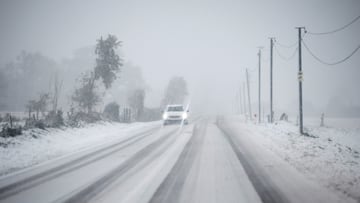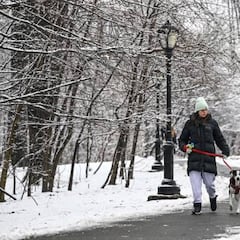This is what experts recommend when it comes to driving in the snow
When possible, avoid driving in severe winter weather. However, if you must venture out, here are some tips to keep you as safe as possible on your journey.

As the cold begins to take hold across most of the United States, drivers are preparing their vehicles for the lower temperatures and dangerous conditions. Venturing out into severe weather is not for the faint of heart, even for experienced drivers, and it is recommended that you just stay home. According to AAA, “winter storms, bad weather and sloppy road conditions are a factor in nearly half a million crashes and more than 2,000 road deaths every winter.”
However, if you absolutely must get in your car to travel, there are safety measures that you can take to avoid becoming another winter weather driving statistic.
Be prepared for adverse conditions
To safely navigate harsh winter conditions, it’s essential to ensure that your car is in excellent condition. Start by getting your vehicle inspected to confirm it’s safe to drive in winter weather. Additionally, switching to winter tires can significantly reduce the risk of accidents caused by vehicle failures.
Especially for snowy and icy conditions, have your tires properly inflated and ensure the tread is in good condition. When traveling farther distances, it is recommended that you always keep at least half a tank of fuel in your vehicle. In case you become stranded or stuck in traffic on a cold day or night, a little extra gas may allow you to use the heat intermittently. Additionally, you should have safety cold-weather gear in your car should you get stuck in the snow or have unforeseen car troubles. This includes warm clothing and blankets to keep you warm; using the car’s heater may not be an option and can be dangerous. Also pack a flashlight, ice scraper, reflective jacket, and flare.
Take along any medications you may need, extra food and water, and a candle should it be necessary to melt snow for water. Also, make sure your cell phone is charged or that you have a portable charger packed in your emergency kit.
With snow in the forecast this week please avoid being on the roads if you can. If you must be on the roads please follow these #WinterStorm driving #TIPS. In bad weather situations #Slowdown, drive slowly & smoothly. #Safe Travels. pic.twitter.com/rzTfm62IGB
— NYPD 109th Precinct (@NYPD109Pct) February 28, 2023
How to drive on snowy and icy roads
Though the advice may sound repetitive, if you can, stay home and stay off the roads during severe weather. But if you insist on venturing out, be cautious and don’t overestimate your abilities. Check the weather forecast before you hit the road, as well as inform family or friends of your route and estimated time of arrival. When starting up your car, don’t let it warm up in an enclosed space to avoid the build-up of carbon monoxide.
Out on the road, drive slowly, as you’ll have less traction when driving on snow and ice. Do not use your cruise control; you should be in control of adjusting the speed of your car. Avoid jackrabbit starts or sudden stops to avoid losing traction and skidding. Give yourself extra distance between the car in front of you and slow down ahead of time when coming to a stop.
Given that it takes more to get a car moving once again from a full stop on slippery surfaces, AAA recommends that when approaching a traffic light, slow down enough that you can keep rolling until it changes to avoid coming to a full stop. And know your brakes—don’t slam on them, but use firm, steady pressure.
When approaching a hill, to avoid applying extra gas and risk your wheels spinning, build up a little inertia before reaching the hill and let it carry you to the top. As you approach the crest of the hill, reduce your speed and go downhill slowly. Avoid stopping while going uphill; getting your car moving up a slippery hill again can be extremely difficult and if roads are icy you risk sliding down.
Light fog overnight, along with residual moisture, will lead to some patchy black ice this morning in northern New Haven, New London, and Middlesex counties. Conditions will improve after sunrise as temperatures rise above freezing. #CTwx pic.twitter.com/Wczfx486m3
— NWS New York NY (@NWSNewYorkNY) November 27, 2024
What to do if you get stuck in the snow
If you get stuck in the snow, don’t panic. The safest thing you can do is stay with your car. It will provide shelter from the elements and make it easier for rescue crews to find you.
Even if you are prepared for an Arctic expedition, going out into a blizzard is extremely dangerous. You can get disoriented easily, especially at night. Even with several layers, you can succumb to exposure if you are out in the elements for an extended period of time.
Before getting out of your car to check your situation, bundle up and put on a reflective jacket. Make sure that your car’s tailpipe is not obstructed by ice, mud, or snow. This is important to avoid deadly carbon monoxide from seeping into the passenger compartment.
Make your car visible by tying a brightly colored cloth to the antenna or at the top of a rolled-up window as a distress signal. If possible, experts recommend keeping your car’s dome light on at night. “It only uses a small amount of electricity and will make it easier for rescuers to find you.”
Related stories
Do not run the engine for long periods of time, only briefly to run the heater, if you must, in order to stay warm. On the one hand to conserve fuel, but more importantly, even if your exhaust pipe is clear, carbon monoxide can still build up in the interior of a stationary car in the open. Better if you can get by using anything you brought to insulate yourself from the cold.
Finally, if you try to dig yourself out of the snow, do not overexert yourself. Listen to your body and stop if you become tired.


Complete your personal details to comment